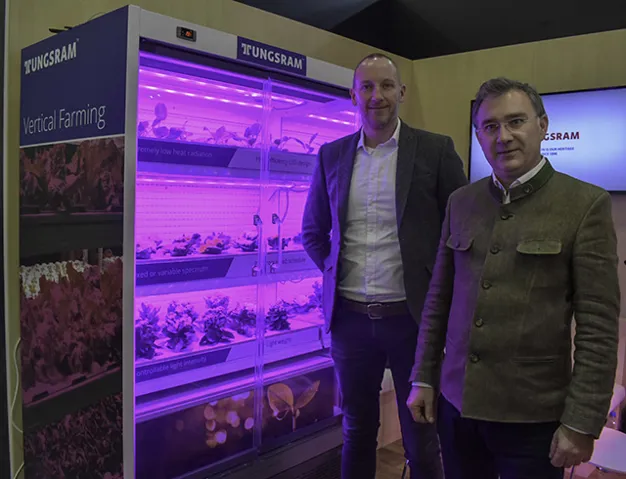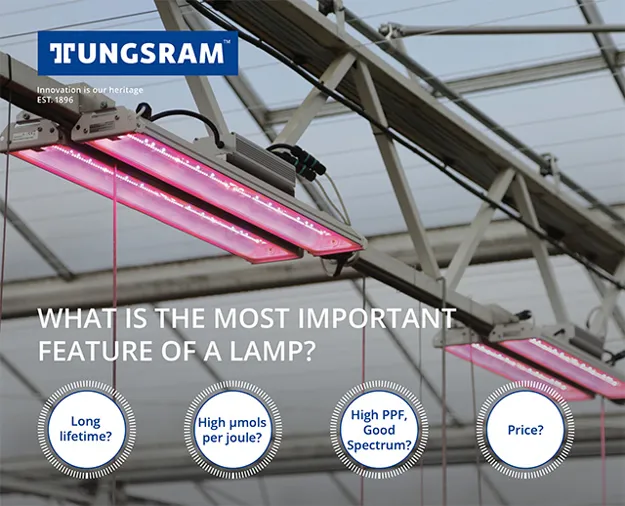Nowadays with continuously increasing energy prices, an efficient way of energy utilization is becoming a major issue in order to run a profitable business and tackle climate changes. Approximately 60-80% of the total electricity cost and 30-40% of the total cost can depend on lighting sources in modern horticulture production facilities. Beyond that, a whopping carbon footprint is generated by the sector as well. In recent years around 1% of total electricity consumption is caused by, a high light-demanding, cannabis production in the US. That's why choosing the proper lighting sources is vital. Today Keith Thomas, commercial director with Tungsram Agritech, explains what to look for when researching LED lights.

“If artificial lighting in a horticultural application is reasonable, the system efficiency of the requested lamps is always a crucial number and asked to be as high as possible. However, high system efficiency, long lifetime, reasonable price and high PPF at a good spectrum are rarely available together,” Keith says. “How should we compare different lamps with the same efficiency or vice versa? What might the unconditionally high-efficiency numbers really mean at the brochure’s frontpage? What can be the positive side of a less efficient lamp built with mainly white or full-spectrum chips?”
The industry measures lamp's efficiency by μmol/J. “This is the PAR photon output divided by the input energy to produce light. In order to choose the right lamp, it is good to know, from a grower perspective, what is contributing to a given system efficiency.”
According to Keith, first is the efficiency of the LED chips. “In normal conditions up to date quality high power red chips delivering at peak performance around 4.1 μmol/J, white around 2.2 μmol/J, blue around 2.6 μmol/J. It is impossible to gain higher lamp efficiency than the efficiency of the chips.”
The peak performance is achieved when chips are driven with electricity at possibly the lowest forward current. In this case, higher efficiency numbers can be gained than the above mentioned, but the efficiency tendency will remain the same between the spectrums. “If a manufacturers strategy to make an efficient LED luminaire with chips driven by low forward current, additional chips are needed in order to keep up the high light output level. This means more cost. On the other hand, chips driven by lower forward current are expected to have a higher lifetime.”
Another method to increase system efficiency is to induce the number of red chips. “What is also generally beneficial for plant growth but of course another wavelength is needed as well”, Keith adds. “It is important to know at lamp comparison what is the exact spectrum of the comparable lamps and where are the peaks within the spectrum. Because values given by code names may vary from each other.”

Then the spectral ratio is also affecting system efficiency. “Perhaps, the red chips wavelength is the most advantageous for plants but it can be partly replaced by more cost-effective white or full-spectrum chips with worse μmol/J. On the other hand, with less efficient white chips higher spectral homogeneity can be achieved which can count when lighting fixtures are placed closely to plant canopy such as in vertical farms.”
Glass or plastic coverage and driver of the lamp can also affect the total efficiency by 4-10%. Active cooling is another approach to improve efficiency and level up heat dissipation but passive cooling lamps can deliver more easily a reliable and durable operation with lower price and weight. “In conclusion, if a comparison is made between two lamps keen on mind the mentioned techniques, prioritize a few features for your goal and ask for the exact details”, Keith advises.
He concludes: “If a lamp with long lifetime, low running cost, high efficiency, strong biomass production ability at humid environment is on focus, a luminaire with a high amount of red chips, driven with quite low forward current in a passive cooling frame is preferable and competitive for the future.”
Visit Tungsram at the Fruit Logistica at hall 21-B08
For more information:
Tungsram
Lőrinc Utasi
Agronomist
lorinc.utasi@tungsram.com
Keith Thomas
Commercial Leader
keith.thomas2@tungsram.com
